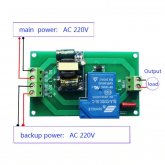Searching for a proper transfer switch allowing me to switch between shore power and inverter power and which depends on shore power available, I found this on AliExpress, which should handle 220VAC and up to 30A.

https://www.aliexpress.com/item/32837077765.html
The working principle explained by seller:
"Principle: two power supply automatically switch continuous power supply.
When the main power supply is energized, the standby power supply is not connected and the main power supply is output; when the main power supply is de-energized, the standby power supply is automatically connected and the standby power output is output; when the main power supply is powered again"
I think, this could be a cheap alternative to the standardized transfer switches available on the market which starts about $50. If it works like it is intended to do. And that's the problem, I haven't made any practical experience with this module yet. Maybe someone else here does?

https://www.aliexpress.com/item/32837077765.html
The working principle explained by seller:
"Principle: two power supply automatically switch continuous power supply.
When the main power supply is energized, the standby power supply is not connected and the main power supply is output; when the main power supply is de-energized, the standby power supply is automatically connected and the standby power output is output; when the main power supply is powered again"
I think, this could be a cheap alternative to the standardized transfer switches available on the market which starts about $50. If it works like it is intended to do. And that's the problem, I haven't made any practical experience with this module yet. Maybe someone else here does?



